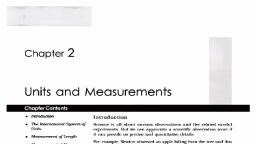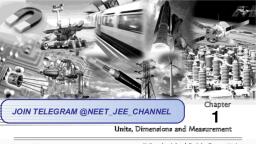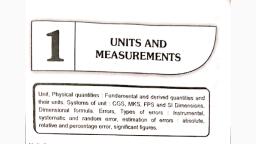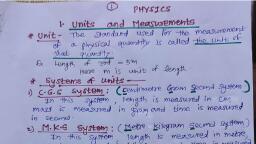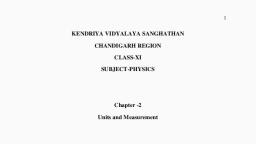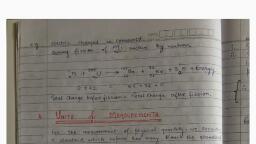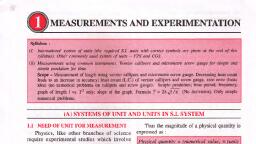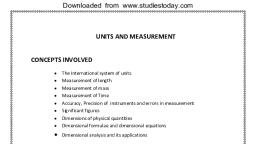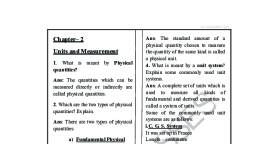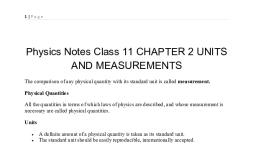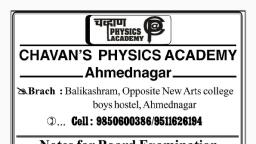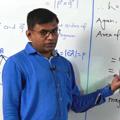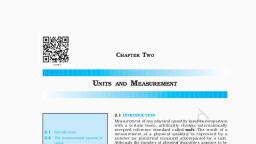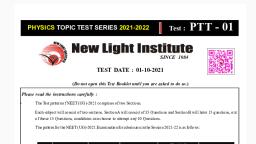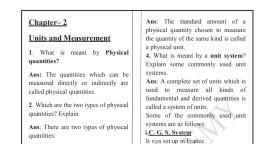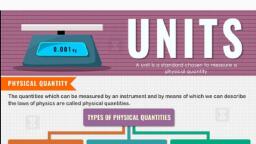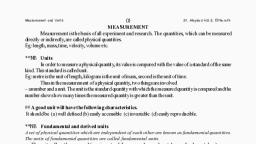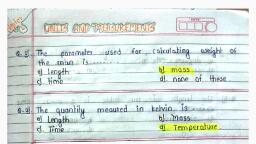Page 1 :
Chapter 1st Units and Measurement, Introduction, Physics is a branch of science dealing with study of matter, energy and their transformations in nature. Physics is the foundation of all technologies in the world., in physics we will be studying properties of matter, laws, phenomenon involved in it. Different quantities used in study of physics are called physical quantities., in physics many natural phenomena are interrelated which need measurement., measurement of physical quantity in its own unit is carried out by comparing it with standard. in this chapter we will study unit dimension an error in measurement, Need of measurement in engineering (अभियांत्रिकीमध्ये मोजमापाची गरज ), The aim of measurement in engineering is to determine whether the product is manufactured as per the required specification., Measurement is basically a source of communication in engineering., Measurement is carried out by comparing the Given physical quantity with standard., Any measurement consist of two parts, For example, Mass of an object is 5 kg., Here,number 5 indicates the magnitude and kg represents the standard (unit)., If all the quantities measured are clearly defined, there is no chance of confusion between two person, Measurement plays key role in development of engineering., Accurate prediction of physical quantities.( भौतिक प्रमाणांचा अचूक अंदाज), Ex – Measurement of length, mass,time,radius Has to be clearly measured for developing engineering product., Quality assurance of product(उत्पादनाची गुणवत्ता हमी)-, Quality depends on factors such as strength of material, correctness, finishing, precision, flexibility, etc before launching the product, all such factors are measured by MQC department of a company., What is Measurement-, Def- Measurement is finding a number that show the size or amount of substance., Any measurement consist of two parts, the first part is number which indicates magnitude of quantity, The second part indicate standard(Unit), Example- 1) 5 kg Sugar., Here, 5 is magnitude and kg is standard (unit), 2) 3 liter milk., Here, 3 is magnitude and liter is standard (unit)., In the above example, the number shows magnitude of quantity and kg and liter is units of this quantities., Unit:-, Definition:- The standard used for measurement of a quantity is called unit of that quantities., Example:-, 10 kg., Here, kg is standard or Unit of mass., 3 meter., Here, meter is standard or unit of length., Requirements of standard unit:-, It should have definite value., It should be universally accepted., It should be well defined., It should be easily reproducible., It should be invariable with time and place., It should be comparible with other same unit., It should be easily available., NON-PHYSICAL QUANTITIES:, Definition:-, Those quantities which cannot be measured are called non-physical quantities., For example: Like, Wish, Sorrow, Hate, Love etc. And all emotions., Physical quantities:-, Definition:-, Those quantities which can be measured are called physical quantities., For example: Length, mass, time, acceleration, momentum etc., In the physical quantity there are two types of quantities, a)base or fundamental quantities, b)Derived quantities, base or fundamental quantities:-, 1.Defination:-, The physical quantities which do not depend on any other quantities for their measurement are called fundamental or base quantities., Note: the unit of fundamental or base quantity is called fundamental or base unit., 2.There are 7 base or fundamental quantities. As follows, There are two additional supplementary quantities as follows., Definition of Basic and Supplementary Unit of S.I:, Meter (m): The meter is the length of the path travelled by light in vacuum during a time interval of 1/299 792 458 of a second., 2. Kilogram (Kg) : The kilogram is the mass of the platinum-iridium prototype which was approved by the Conference of General Measures, held in Paris in 1889, and kept, by the Bureau ., Second (s): The second is the duration of 9192631770 periods of the radiation corresponding to the transition between two hyperfine levels of the ground state of Cesium-133 atom., 4. Ampere (A) : The ampere is the intensity of a constant current which, if maintained in two straight parallel conductors of infinite length, of negligible circular cross-section, and placed 1 meter apart in vacuum, would produce between these conductors a force equal to 2×10^-7Newton per meter of length., 5. Kelvin (K): Kelvin is the fraction 1/273.16 of the thermodynamic temperature of the triple point of water., 6. Candela (Cd): The candela is the luminous intensity, in a given direction, of a source that emits monochromatic radiation of frequency 540 x 1012 hertz and that has a radiant intensity, in that direction of 1/683 watt per steradian., 7.Mole (mol): The mole is the amount of substance of a system which contains as many elementary entities as there are atoms in 0.012 kilogram of Carbon-12., Supplementary units:, 1. Radian (rad): It is supplementary unit of plane angle. It is the plane angle subtended at the center of a circle by an arc of the circle equal to the radius of the circle. Demoted by thita., 2. Steradian (Sr): It is supplementary unit of solid angle. It is the angle subtended at the center of a sphere by a surface area of the sphere having magnitude equal to the square of the radius of the sphere. It is denoted by Ω., Ω = ∆s / r2, Derived physical quantities :, Definitions: the physical quantities which depends on one or more fundamental physical quantity are called Derived physical quantities., Note: The unit of derived quantity is called derived unit., Here, several Derived physical quantities, Example: area, volume, velocity, power, density, momentum, surface tension, pressure, electric field …etc., Prefixes of multiples and submultiples of unit:, Uses of prefixes:, 3 milliampere = 3 mA = 3 × 10^-3 A, 5 microvolt = 5 μV = 5 x 10^-6 v, 8 nanosecond = 8 ns = 8 x 10^-9 s, 6 picometre = 6 pm = 6 x 10^-12 m, 5 kilometer = 5 km = 5 x 10³ m, 7 megawatt = 7 MW = 7 x 10⁶ W, Difference between fundamental and derived quantity






